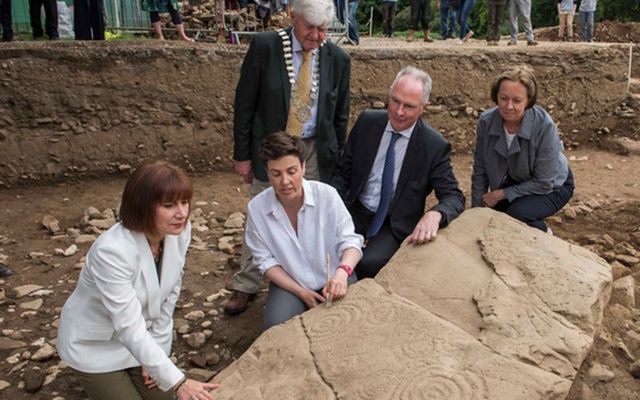Archaeologists in Ireland made a major new discovery at the Brú na Bóinne World Heritage Site in July 2018, revealing a 5,500-year-old megalithic passage tomb cemetery that is being described as a "find of a lifetime."
Following research carried out by agri-technology company Devenish and University College Dublin School of Archaeology, two burial chambers were discovered within the western part of the main passage tomb beside the 18th-century Dowth Hall in Co Meath.
The chambers were covered by a large stone cairn which was around 131 feet (40 meters) in diameter.
"For the archaeologists involved in this discovery, it is truly the find of a lifetime,” Dr. Clíodhna Ní Lionáin, Devenish's lead archaeologist for the project told RTÉ.
“The find of a lifetime” - archaeologist Dr Clíodhna Ní Lionáin on the discovery of a Megalithic passage tomb dating back some 5,500 years at the 18th century Dowth Hall in County Meath. pic.twitter.com/MhkAAoCTxp
— Philip Bromwell (@philipbromwell) July 16, 2018
The archaeological research has also discovered six kerbstones which would have formed part of a ring of stones that followed the cairn perimeter. The cairn is a mound of rough stones built over the burial chamber as a landmark, whereas the kerbstones would have marked the outside of this mound. One of the kerbstones identified is heavily decorated with Neolithic carvings and is said to be one of the most impressive discoveries of megalithic art in Ireland for decades.
The discovery came less than a week after major new finds in the Co Meath Brú na Boinne prehistoric complex. With thanks to the drought caused by a heatwave in Ireland, historian and photographer Anthony Murphy discovered a henge up to 656 feet (200m) in diameter near Newgrange while flying a drone in the area.
Thrilled to have discovered a previously unknown "new" henge monument near Newgrange last night. Archaeologists tell me that this is a very major find. It appears to be similar in design and size to the nearby Site P, a recorded henge. Exciting times! https://t.co/Mp2pWY26Dr pic.twitter.com/CIdPSTCEJX
— Mythical Ireland (@mythicalireland) July 11, 2018
"Myself and Ken Williams of Shadows and Stone imaged some very substantial and previously unrecorded features in the fields near Newgrange this evening," he wrote.
"They look like giant henges or enclosures, very similar in scale to Site P, and forming a row-of-three with P. Have a look at these very exciting photographs.
"If these turn out to be substantial discoveries, then I would be nothing short of utterly elated, chuffed and excited. We're already discussing them with an archaeologist and to say he's very excited is a huge understatement!"
BREAKING NEWS: Archaeological excavations at Dowth Hall, Co. Meath have uncovered a monumental passage tomb, complete with kerbstones, quartz and STUNNING rock art. Fantastic work by Dr Clíodhna Ní Lionáin, @ucdarchaeology and @DevenishNutri. @DiscoverBoyneV @irarchaeology pic.twitter.com/o82fZlKolc
— Ciarán McDonnell (@DrCiaranMcDonn) July 16, 2018
Newgrange dates from approximately 3,000 BC, but this new find could have been constructed 500 years after the UNESCO World Heritage site.
The Irish Department of Culture, Heritage and the Gaeltacht described the uncovering of the 656-foot wide circle as “a very significant find” and carried out their own aerial survey which showed further "unparalleled" prehistoric sites.
“The reconnaissance carried out Friday by archaeologists from our National Monuments Service has resulted in the discovery of an array of very significant additional archaeological features in the vicinity across the River Boyne floodplain south of the Newgrange passage tomb,” said Irish Minister for Heritage Josepha Madigan after the government’s survey.
“With further research, we know these fascinating finds will add greatly to our knowledge of the wonderful Brú na Bóinne World Heritage landscape.”
“My department wants to promote knowledge of archaeological discoveries & are delighted that this site will open to the public during Heritage Week next month”. Speaking at #Dowth Hall today where remains of 5,500 yr old Passage Tomb has been discovered @DeptAHG @ucdarchaeology pic.twitter.com/oehIdlaahH
— ⚖️Josepha Madigan (@josephamadigan) July 16, 2018
These discoveries are also believed to date to the Neolithic period some 5,000 years ago. Government officials will now research further to map the new discoveries in the hope of understanding their connection with the other known megalithic monuments in the area.
Brú na Boinne (which is Irish for the Palace of the Boyne) refers to the area within the bend of the River Boyne in Co Meath which contains one of the world’s most important prehistoric landscapes. The UNESCO World Heritage site is dominated by the three well-known large passage tombs, Newgrange, Knowth, and Dowth with Knowth, in particular, containing the largest assemblage of megalithic art in western Europe.
"This is the most significant megalithic find in Ireland in the last 50 years, since the excavation of Knowth,” said Dr. Stephen Davis of the UCD School of Archaeology of the latest megalithic tomb find.
"The spate of archaeological discoveries in Brú na Bóinne in recent weeks highlights what a globally significant place this is."
Today Minister for Culture, Heritage and the Gaeltacht @josephamadigan unveiled the 5,500 year old passage tomb cemetry that has been unearthed at the Devenish Lands at Dowth. This is the find of a lifetime following a partnership with @ucdarchaeology and Devenish. pic.twitter.com/gWOs2FK5ZN
— Devenish (@DevenishNutri) July 16, 2018
"Devenish invested in this farm at Dowth because of its fertile soil, its location beside the Boyne, and its beautiful landscape,” added Owen Brennan, Executive Chairman of Devenish.
"From our archaeological research, it seems we made the same decision for the same reasons as a long line of our farming colleagues from the Neolithic, the Bronze Age, medieval, and more recent times.
"The monuments here, created by some of Ireland's first farmers, capture our imaginations and those of our visitors to the Devenish Lands of Dowth. It is an inspirational landscape to showcase Devenish's work on sustainable agriculture and promoting human health through nutrition."
* Originally published in July 2018. Last updated in August 2023.




Comments